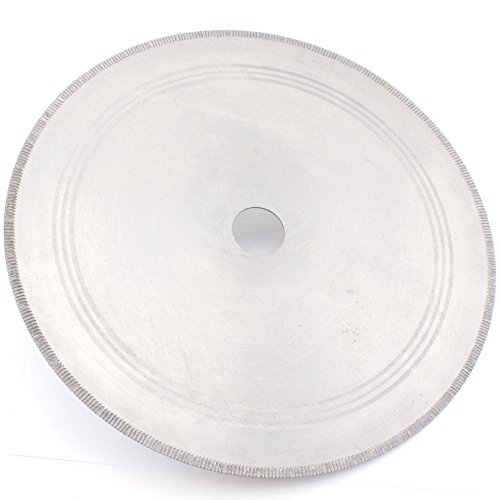You might not know that not all diamond blades are created equal, especially when it comes to circular saws. Choosing the right blade can greatly impact the quality of your cuts, whether you're working with concrete pavers, lapidary materials, or cement and stone. With the Paver Master, ILOVETOOL, and Trabo blades, you'll find specialized options that cater to different needs. Each offers unique advantages, but which one suits your project best?
key Takeaways
- Paver Master Diamond Blades offer durability and precision for concrete pavers, roofing tiles, and granite.
- ILOVETOOL 14 Inch Lapidary Diamond Saw Blade excels in cutting jasper and agate with consistent sharpness.
- Trabo 7 Inch Masonry Diamond Blade provides excellent value for cutting cement, pavers, and natural stone.
- Consider blade size compatibility and material composition for optimal cutting efficiency.
- Regular maintenance enhances blade performance and longevity during cutting tasks.
Paver Master Diamond Blades for Concrete Pavers (6 Pack)
If you're tackling projects involving concrete pavers, roofing tiles, or granite, the Paver Master Diamond Blades are your best bet. These blades, sold in a convenient six-pack, are designed for both wet and dry cutting, making them versatile for various conditions. Their 8mm segment height and reinforced segments guarantee durability, providing clean cuts without defects, even through large projects. Users rave about their performance, especially in cutting 2" x 8" cement paving stones. Remember to wear a dust mask and eye protection for safety. With these blades, you'll achieve professional results effortlessly, whether you're a seasoned pro or a DIY enthusiast.
Best For: Professionals and DIY enthusiasts working on projects involving concrete pavers, roofing tiles, and granite.
Pros:
- Durable with reinforced segments for clean cuts.
- Suitable for both wet and dry cutting methods.
- Effective on large projects without defects.
Cons:
- Requires use of dust mask and eye protection for safety.
- Limited to specific applications such as concrete pavers and granite.
- May not be suitable for materials outside the specified applications.
ILOVETOOL 14 Inch Lapidary Diamond Saw Blade
When you're searching for a reliable diamond blade for your circular saw, the ILOVETOOL 14 Inch Lapidary Diamond Saw Blade stands out for its versatility and durability, making it an excellent choice for lapidary enthusiasts and professionals. This notched rim blade, with a core thickness of 0.039 inches and a rim thickness of 0.051 inches, effortlessly cuts through both soft and hard rocks like jasper and agate. Users rave about its longevity, successfully cutting around 100 slabs with cooling oil while retaining impressive sharpness. Proper maintenance guarantees it remains corrosion-free, and its smooth arbor hole makes installation a breeze.
Best For: Lapidary enthusiasts and professionals looking for a reliable and durable diamond saw blade for cutting a variety of rock hardness levels.
Pros:
- Versatile in cutting both soft and hard lapidary materials.
- High durability, capable of cutting approximately 100 slabs while maintaining sharpness.
- Positive user feedback on cost-effectiveness and performance.
Cons:
- Requires proper maintenance to prevent corrosion.
- As it dulls, additional blades may need to be purchased for backup.
- No immediate quality concerns reported, but long-term durability beyond initial use not guaranteed.
Trabo 7 Inch Masonry Diamond Blade for Cutting Cement and Stone
The Trabo 7 Inch Masonry Diamond Blade stands out as an exceptional choice for professionals tackling tough materials like cement, pavers, and natural stone. It slices through concrete with rebar and cinder blocks like they're butter. The blade's segmented rim and diamond bond guarantee precision and durability, even under heavy use. With a thickness of .085 inches, it's compatible with angle grinders and circular saws, cutting wet or dry. Users report excellent performance and recommend using a real respirator due to dust. Its value for money is unbeatable, and most users plan to buy more, praising its efficiency and longevity.
Best For: Professionals and DIY enthusiasts needing a reliable blade for cutting through tough materials like cement, pavers, and natural stone.
Pros:
- Efficiently cuts through concrete, rebar, and cinder blocks with precision.
- Compatible with both angle grinders and circular saws for versatile use.
- Offers excellent value for money with long-lasting performance.
Cons:
- Generates significant dust, necessitating the use of a real respirator.
- Setup may be delayed if the center adapter is misplaced.
- Speed of cutting may decrease with prolonged use.
Factors to Consider When Choosing a Diamond Blade for a Circular Saw
When choosing a diamond blade for your circular saw, start by considering the blade's material composition and how it affects cutting efficiency. Confirm the blade size is compatible with your saw and offers versatility across different materials. Finally, evaluate the blade's durability and longevity to get the best value for your investment.
Blade Material Composition
Choosing the right diamond blade for your circular saw involves understanding its material composition, as it greatly impacts cutting performance. The core is typically steel, while the diamond segment comprises synthetic or natural diamonds for superior cutting. Pay attention to the blade's thickness; thinner blades offer smoother cuts but may wear out faster. The diamond bond type matters too—softer bonds excel at cutting hard materials, whereas harder bonds are ideal for softer ones. High-quality diamonds in the segments guarantee longevity and cleaner cuts. Don't overlook the segment's height and shape, as these factors influence cutting speed and material suitability. By carefully considering these elements, you can choose a diamond blade that meets your precise cutting needs effectively.
Cutting Efficiency Levels
Understanding cutting efficiency levels is vital when selecting a diamond blade for your circular saw. Look for blades with taller segment heights, like 8mm, which excel at slicing through tough materials such as concrete and natural stone. Opting for wet cutting blades is beneficial since they keep temperatures down, reducing wear and boosting performance over dry cutting alternatives. Proper arbor size is important; a 7/8-5/8 arbor guarantees your blade fits snugly, enhancing stability and efficiency. Blade thickness matters too—masonry blades around 0.085 inches thick handle dense materials without bending or binding. Finally, consider the cutting method. Wet cutting not only minimizes dust but also improves visibility, making your cutting experience smoother and more efficient.
Blade Size Compatibility
Blade size compatibility is key to getting the best performance from your circular saw. Match the blade diameter with your saw's specifications for safe, effective operation. Common sizes range from 4 to 14 inches, each suited for different tasks. Smaller blades excel in precision work, while larger ones cut faster and tackle thicker materials.
Don't forget the arbor hole size—ensure it aligns with your saw's arbor. Typical sizes include 1 inch, 5/8 inch, and 7/8 inch, but bushings can help fit mismatched sizes. Additionally, consider blade thickness, as it impacts cutting depth and efficiency with various materials. By ensuring compatibility in these areas, you'll extend the life of your tools and achieve cleaner, more precise cuts.
Versatility Across Materials
When you're selecting a diamond blade for your circular saw, versatility across materials is a key consideration. Look for blades that can handle various tasks, like cutting through concrete pavers, roofing tiles, and granite. Blades with reinforced segments offer enhanced strength, making them ideal for tough materials such as cement, natural stone, and concrete with rebar. Consider the segment height; higher segments boost cutting efficiency on dense materials. Opt for blades capable of both wet and dry cutting to maximize their use in different environments. Finally, verify the blade's arbor size matches your tools, like angle grinders or circular saws, for seamless fitting and usability across projects. The right blade will adapt to your diverse cutting needs.
Durability and Longevity
While choosing a diamond blade for your circular saw, you should consider durability and longevity as key factors. Look at the segment height; taller segments usually mean a longer-lasting blade because they resist wear better. If you're cutting specific materials like concrete or natural stone, select a blade designed for that purpose to guarantee peak performance and lifespan. Regular maintenance, such as cleaning and using cooling agents, prevents overheating and corrosion, thereby extending the blade's life. User feedback indicates some blades can handle over 100 cuts before dulling, so quality matters. Pay attention to the blade's construction materials—thicker blades with high-quality diamond bonds tend to be more durable and handle tough tasks effectively.





